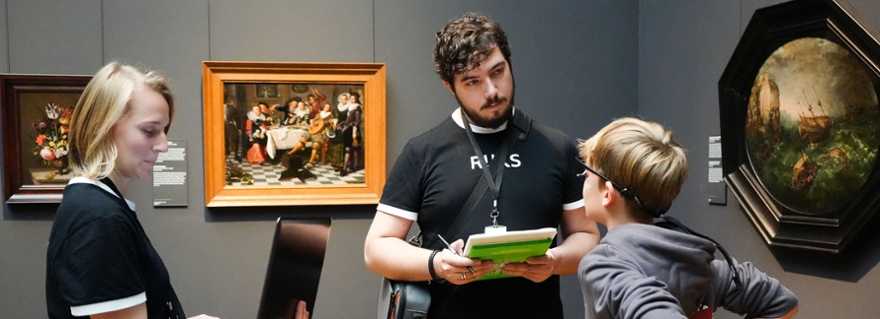
What do children see in art? Psychologists are studying this at the Rijksmuseum
From games to scavenger hunts: museums already do all sorts of things for children. But how do children really look at art? Do paintings affect them more if they receive information that is specially tailored to young visitors? Join psychologist Francesco Walker at the Rijksmuseum in Amsterdam and see how his team is researching this with eye trackers.
It’ll be a familiar scene to many a parent and museum visitor: children either frenetically doing a scavenger hunt through the museum or tearing through the galleries without stopping to admire the art. ‘More research is needed to really understand what influences children’s aesthetic tastes,’ says Leiden psychologist Francesco Walker. That’s why he and his team are conducting research at the Rijksmuseum. His team exists of master students from Leiden University, the psychologists Jan Theeuwes and Joshua Snell of VU Amsterdam and Berno Bucker from Attention Architects. What does eye-tracking research entail and what visual strategy do children use? Take a look behind the scenes at the eye-tracking research at the Rijksmuseum.
Due to the selected cookie settings, we cannot show this video here.
Watch the video on the original website orHow well does storytelling work?
‘Our research could be an important step in the development of information materials and educational tools for children,’ says Walker. ‘We know, for example, that storytelling can be an effective tool for this group. The Rijksmuseum kept this in mind in the descriptions of the paintings in our study. The texts make a concrete connection to the painting and should thus encourage the children to look. Does this make them pay more attention to details they would otherwise ignore? Do they look more carefully, and do they feel a stronger connection to the artworks? We are now investigating whether this is the case.’ Two Leiden master's students - Kim Houwaart and Reinout Van den Brink - guide the children past the paintings with their eyetrack glasses and ask them questions about the artworks afterwards. In the video Walker, against a backdrop of 17th-century paintings, explains how children and adults look differently at art.
Due to the selected cookie settings, we cannot show this video here.
Watch the video on the original website orWhat makes 10- to 12-year-olds particularly interesting?
The researchers deliberately chose participants aged 10 to 12, says Walker. Around this age, children develop abstract thinking and that affects the way they classify objects and experiences, and thus the way they see the world. ‘We know that children in this age group use different visual strategies from adults when viewing paintings. Our previous research at the Van Gogh Museum shows that children in this age group are more immediately drawn to areas in paintings that stand out, for example, because of their colour or shape.’
Pauline Kintz, the head of the Public sub-team at the Rijksmuseum, agrees that this age group is particularly interesting. ‘From around the age of ten, children enter a developmental stage where they become more interested in context. They become interested in the past and history, and become curious about the story behind a painting, about why certain details are there. So they are open to new information and want to discover new things. And of all the children who visit the Rijksmuseum, this age group is the largest.’ Some children find looking at art 'boring', Walker notes. How does he want to change that? Watch the following clip.
Due to the selected cookie settings, we cannot show this video here.
Watch the video on the original website orWhat does the Rijksmuseum have to offer children?
The already Rijksmuseum has a wide range of activities for children, such as a digital family game, a route for young children and creative workshops and tours. But the texts in the galleries have not yet been written specifically for children. ‘For each object, adults can read a text that tells them more about what they are looking at, but we don’t have that for children yet,’ says Kintz. ‘That’s why we’re happy to cooperate with the eye-tracking research. It’s a great opportunity for us to learn more about children’s viewing behaviour. We can’t wait to see the data and its analysis. We want to be a museum for everyone and thus tell stories that are accessible to all. For us the goal isn’t that children like the artworks but that they do look at and form an opinion on them.’
The research team hopes to publish its results during 2023.
Text: Linda van Putten
Video series: Suédy Mauricio & Fien Leeflang
Banner photo: Anne Holleman
